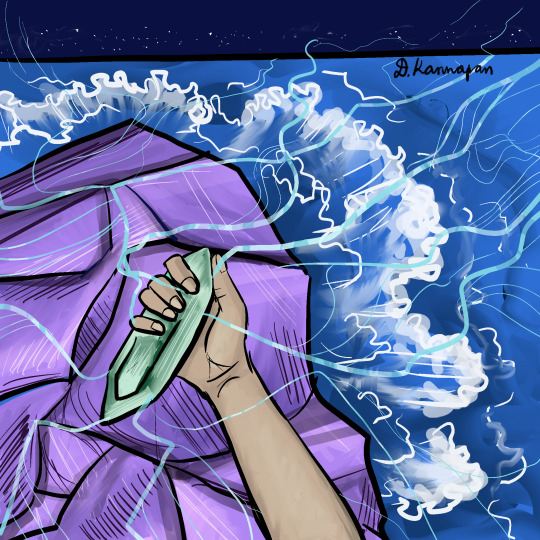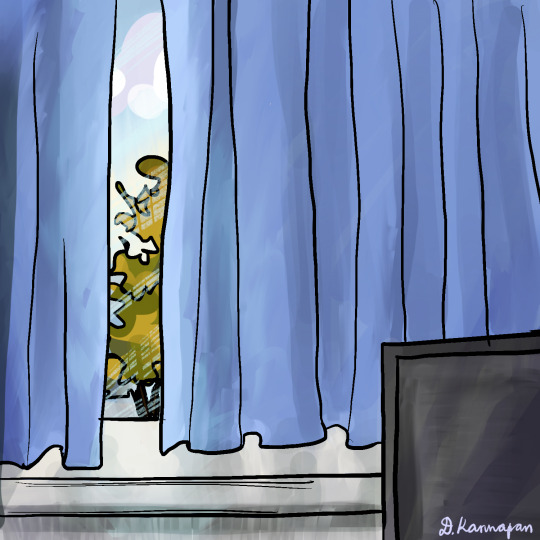Text

A quick drawing I made in response to a prompt: ‘Treasures’
6 notes
·
View notes
Text
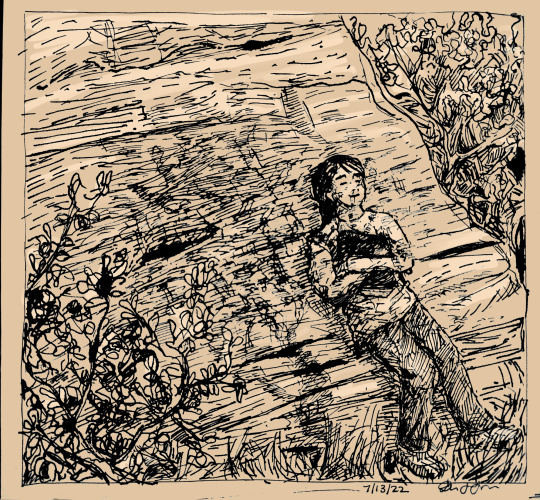


Girls in nature! (See if you can spot the girl in the last one, lol)
I wrote about the process of making these on Medium. “Nature Girl” Ink Drawings — Incorporating Characters into Landscapes
[…] I decided to try something weird. I would draw a landscape, and basically make the character an outgrowth of natural features. Like she was some kind of nature-spirit.
9 notes
·
View notes
Text
One year ago, today!
The Climate Movement Needs Your Creativity, Not Your Guilt
(This is an annotated transcript of the TEDx talk I gave in April 2023. It’s 10 minutes long. I’d suggest watching it first and then coming here for supporting materials.)
youtube
Does climate action feel impossible?
When I was a kid, I was interested in everything. I’d need about 10 careers to do it all. So I got out my green and blue markers and made a calendar to keep track of which job I’d have on which day of the week. On Monday, I’d be a scientist, on Tuesday, a painter. Friday — some kind of explorer, because I loved nature documentaries. I related to how animals seemed fascinated by whatever was right in front of them.
Every documentary ended with a reminder that these animals needed our help, and all the ways they were threatened by human activity. I couldn’t believe no one had managed to do something about this. But I figured I would know how when I grew up.
So, though I kept changing my mind about what I would be, the one constant was that it would have something to do with climate and conservation.
Years later, I was working as an engineer and plugging away at my art and writing. I didn’t tell anyone about my master plan to connect it all to climate, but I hadn’t forgotten it. I kept looking for ways to make my engineering work overlap with climate science or renewables.
Still, I avoided climate news. I didn’t need to hear over and over that climate change REALLY WAS real to motivate me to take action. I didn’t need to see a picture of an animal choking on plastic; I already had the master plan. Meanwhile, I kept circling climate action from a distance without taking the plunge.
But that changed in 2020. The United Nations issued a report giving us a deadline of 2030 to make steep emissions cuts.
Taking action couldn’t stay theoretical and future tense any longer. So I dove into the research to catch up on what I had missed. And I started — tentatively — talking to people about climate change and my intentions.
And I got wave after wave of bad news. It wasn’t just the tight deadlines, scale of changes needed, and years of deadlock.
It was also the confusing responses I was getting in my conversations about climate change. I’d bring up something I found fascinating, people’s faces would drop. The’d say “Yeah… I should be doing more.” And the conversation stopped there.
We’d all finally grown up! and I was ready to jump into the master plan, but I hadn’t factored in when I was 10 that no one would want to jump with me.
And it was 2020, and the air in California was full of wildfire smoke — a constant reminder of what was at stake.
Defeatism had hijacked the climate conversation and it was everywhere.
Eventually, the gloom shifted just enough for me to start wondering. Maybe we were all so bummed because we couldn’t see through the haze. We’ve all been peppered with directives — reduce, reuse, recycle. Drive less. Fly less. Turn off lights. Don’t buy plastic.
And we try, pushing against a system that wasn’t set up for any of that. But we don’t have a clear picture of how this helps.
We may have a vague idea of our individual reductions adding up to collective reductions — but then, every single one of us would have to cut our individual emissions by over half, and then to zero. We can’t imagine the effort it would take to scale up our reductions by that much. And convincing every single human to do the same? Impossible.
This picture doesn’t add up because it requires us all to be perfect. And worse, it makes us feel like we are failing, every single day.
But let me paint you a different picture. If change could only happen with 100% participation and perfection, change would never happen. But I think we can all agree that sometimes change does happen, even positive change. So — how?
For one thing, you can move society in a positive direction without being perfect. Think of it like electric current. We are the electrons.
When we imagine current flowing through a wire, we might imagine an orderly stream of electrons all moving in the same direction.

But actually, even before the current starts, the electrons are moving — randomly, at high speeds, in all directions.

And when we apply a voltage to create current, it still looks like they’re moving at random, except there’s a change you can only see when you look at the wire as a whole.

Each electron shifts its velocity a tiny bit, all in the same direction. You don’t need perfect electrons to create current.

Society is a bit more complicated than electric current. Still, it doesn’t matter that we aren’t each moving in a perfectly sustainable direction as long as our changes line up. And more importantly, pick up speed.
So what’s the voltage that directs us? I called it “the system,” and what I mean is the way all the organizations that touch our lives are set up — what they prioritize and where they get their materials.
We are constantly pushing against the system while trying to influence “our” consumption. What if we tried influencing the system instead?
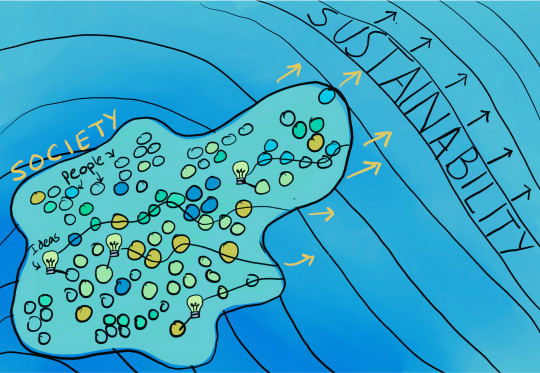
Nearly every social movement that succeeded followed this pattern of slow, then all at once. To get to that point, a certain percentage of people need to participate (estimated variously as 3.5%, to 25%), but importantly, it’s not 100%.
So don’t think of the climate movement as something you’re guilted into. You can choose to be one of the 25% who become early adopters of change.
And you don’t have to worry about the people you can’t convince. They will change when the system changes because that comes first.
Changing the system requires creativity. The first act of creativity is to imagine the possible paths to transformation.
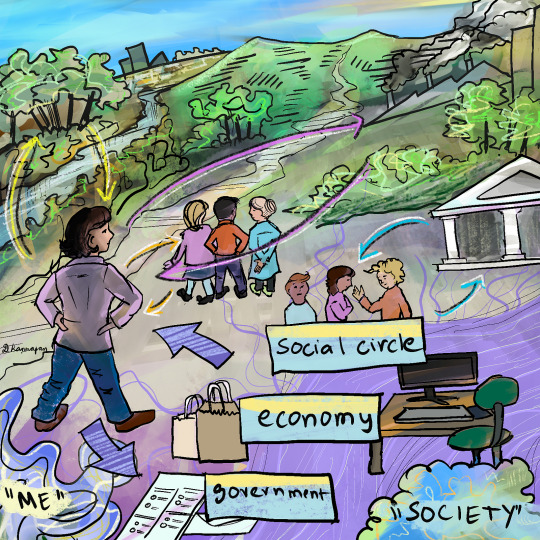
To make that happen, ask yourself these three questions.
One. What is a movement you want to throw your weight behind? Pick a trend or organization that’s already building, and that you can help accelerate. You can be another piece of its critical mass.
Two. What’s a practical obstacle that’s been keeping you from participating? Anything from not knowing what a word means, to having trouble deciding where to volunteer.
If you have this obstacle, others do too. So brainstorming a solution will help more than just you. That obstacle doesn’t stand a chance against your formidable skills at creative problem solving!
Question Three. What social circles that you’re already a part of, can you share your solutions and experiences with? Sharing in the circles where you can be heard is how your solutions amplify and ripple outward.
We’re facing unprecedented challenges, so our imaginations need to be nimble — zipping like a hummingbird — from the big picture, to our immediate surroundings. From where we’re starting from — to where we want to get to.
We can’t be nimble like this if we’re stuck in guilt and perfectionism, and gazing endlessly within our own homes and wallets at all the things we’re doing wrong.
No movement in history has been made up of perfect people, so stop worrying about the ways you’re not perfect. Perfect people are not required.
Instead, think of all the ways your creativity could accelerate us in the right direction.
If you haven’t already, check out the recording of my TEDx talk! And you can hit ‘like’ on the video if you want to help get the YouTube algorithm to distribute it.
86 notes
·
View notes
Text
The Climate Movement Needs Your Creativity, Not Your Guilt
(This is an annotated transcript of the TEDx talk I gave in April 2023. It’s 10 minutes long. I’d suggest watching it first and then coming here for supporting materials.)
youtube
Does climate action feel impossible?
When I was a kid, I was interested in everything. I’d need about 10 careers to do it all. So I got out my green and blue markers and made a calendar to keep track of which job I’d have on which day of the week. On Monday, I’d be a scientist, on Tuesday, a painter. Friday — some kind of explorer, because I loved nature documentaries. I related to how animals seemed fascinated by whatever was right in front of them.
Every documentary ended with a reminder that these animals needed our help, and all the ways they were threatened by human activity. I couldn’t believe no one had managed to do something about this. But I figured I would know how when I grew up.
So, though I kept changing my mind about what I would be, the one constant was that it would have something to do with climate and conservation.
Years later, I was working as an engineer and plugging away at my art and writing. I didn’t tell anyone about my master plan to connect it all to climate, but I hadn’t forgotten it. I kept looking for ways to make my engineering work overlap with climate science or renewables.
Still, I avoided climate news. I didn’t need to hear over and over that climate change REALLY WAS real to motivate me to take action. I didn’t need to see a picture of an animal choking on plastic; I already had the master plan. Meanwhile, I kept circling climate action from a distance without taking the plunge.
But that changed in 2020. The United Nations issued a report giving us a deadline of 2030 to make steep emissions cuts.
Taking action couldn’t stay theoretical and future tense any longer. So I dove into the research to catch up on what I had missed. And I started — tentatively — talking to people about climate change and my intentions.
And I got wave after wave of bad news. It wasn’t just the tight deadlines, scale of changes needed, and years of deadlock.
It was also the confusing responses I was getting in my conversations about climate change. I’d bring up something I found fascinating, people’s faces would drop. The’d say “Yeah… I should be doing more.” And the conversation stopped there.
We’d all finally grown up! and I was ready to jump into the master plan, but I hadn’t factored in when I was 10 that no one would want to jump with me.
And it was 2020, and the air in California was full of wildfire smoke — a constant reminder of what was at stake.
Defeatism had hijacked the climate conversation and it was everywhere.
Eventually, the gloom shifted just enough for me to start wondering. Maybe we were all so bummed because we couldn’t see through the haze. We’ve all been peppered with directives — reduce, reuse, recycle. Drive less. Fly less. Turn off lights. Don’t buy plastic.
And we try, pushing against a system that wasn’t set up for any of that. But we don’t have a clear picture of how this helps.
We may have a vague idea of our individual reductions adding up to collective reductions — but then, every single one of us would have to cut our individual emissions by over half, and then to zero. We can’t imagine the effort it would take to scale up our reductions by that much. And convincing every single human to do the same? Impossible.
This picture doesn’t add up because it requires us all to be perfect. And worse, it makes us feel like we are failing, every single day.
But let me paint you a different picture. If change could only happen with 100% participation and perfection, change would never happen. But I think we can all agree that sometimes change does happen, even positive change. So — how?
For one thing, you can move society in a positive direction without being perfect. Think of it like electric current. We are the electrons.
When we imagine current flowing through a wire, we might imagine an orderly stream of electrons all moving in the same direction.

But actually, even before the current starts, the electrons are moving — randomly, at high speeds, in all directions.

And when we apply a voltage to create current, it still looks like they’re moving at random, except there’s a change you can only see when you look at the wire as a whole.

Each electron shifts its velocity a tiny bit, all in the same direction. You don’t need perfect electrons to create current.

Society is a bit more complicated than electric current. Still, it doesn’t matter that we aren’t each moving in a perfectly sustainable direction as long as our changes line up. And more importantly, pick up speed.
So what’s the voltage that directs us? I called it “the system,” and what I mean is the way all the organizations that touch our lives are set up �� what they prioritize and where they get their materials.
We are constantly pushing against the system while trying to influence “our” consumption. What if we tried influencing the system instead?

Nearly every social movement that succeeded followed this pattern of slow, then all at once. To get to that point, a certain percentage of people need to participate (estimated variously as 3.5%, to 25%), but importantly, it’s not 100%.
So don’t think of the climate movement as something you’re guilted into. You can choose to be one of the 25% who become early adopters of change.
And you don’t have to worry about the people you can’t convince. They will change when the system changes because that comes first.
Changing the system requires creativity. The first act of creativity is to imagine the possible paths to transformation.

To make that happen, ask yourself these three questions.
One. What is a movement you want to throw your weight behind? Pick a trend or organization that’s already building, and that you can help accelerate. You can be another piece of its critical mass.
Two. What’s a practical obstacle that’s been keeping you from participating? Anything from not knowing what a word means, to having trouble deciding where to volunteer.
If you have this obstacle, others do too. So brainstorming a solution will help more than just you. That obstacle doesn’t stand a chance against your formidable skills at creative problem solving!
Question Three. What social circles that you’re already a part of, can you share your solutions and experiences with? Sharing in the circles where you can be heard is how your solutions amplify and ripple outward.
We’re facing unprecedented challenges, so our imaginations need to be nimble — zipping like a hummingbird — from the big picture, to our immediate surroundings. From where we’re starting from — to where we want to get to.
We can’t be nimble like this if we’re stuck in guilt and perfectionism, and gazing endlessly within our own homes and wallets at all the things we’re doing wrong.
No movement in history has been made up of perfect people, so stop worrying about the ways you’re not perfect. Perfect people are not required.
Instead, think of all the ways your creativity could accelerate us in the right direction.
If you haven’t already, check out the recording of my TEDx talk! And you can hit ‘like’ on the video if you want to help get the YouTube algorithm to distribute it.
86 notes
·
View notes
Text
The Climate Movement Needs Your Creativity, Not Your Guilt
(This is an annotated transcript of the TEDx talk I gave in April 2023. It’s 10 minutes long. I’d suggest watching it first and then coming here for supporting materials.)
youtube
Does climate action feel impossible?
When I was a kid, I was interested in everything. I’d need about 10 careers to do it all. So I got out my green and blue markers and made a calendar to keep track of which job I’d have on which day of the week. On Monday, I’d be a scientist, on Tuesday, a painter. Friday — some kind of explorer, because I loved nature documentaries. I related to how animals seemed fascinated by whatever was right in front of them.
Every documentary ended with a reminder that these animals needed our help, and all the ways they were threatened by human activity. I couldn’t believe no one had managed to do something about this. But I figured I would know how when I grew up.
So, though I kept changing my mind about what I would be, the one constant was that it would have something to do with climate and conservation.
Years later, I was working as an engineer and plugging away at my art and writing. I didn’t tell anyone about my master plan to connect it all to climate, but I hadn’t forgotten it. I kept looking for ways to make my engineering work overlap with climate science or renewables.
Still, I avoided climate news. I didn’t need to hear over and over that climate change REALLY WAS real to motivate me to take action. I didn’t need to see a picture of an animal choking on plastic; I already had the master plan. Meanwhile, I kept circling climate action from a distance without taking the plunge.
But that changed in 2020. The United Nations issued a report giving us a deadline of 2030 to make steep emissions cuts.
Taking action couldn’t stay theoretical and future tense any longer. So I dove into the research to catch up on what I had missed. And I started — tentatively — talking to people about climate change and my intentions.
And I got wave after wave of bad news. It wasn’t just the tight deadlines, scale of changes needed, and years of deadlock.
It was also the confusing responses I was getting in my conversations about climate change. I’d bring up something I found fascinating, people’s faces would drop. The’d say “Yeah… I should be doing more.” And the conversation stopped there.
We’d all finally grown up! and I was ready to jump into the master plan, but I hadn’t factored in when I was 10 that no one would want to jump with me.
And it was 2020, and the air in California was full of wildfire smoke — a constant reminder of what was at stake.
Defeatism had hijacked the climate conversation and it was everywhere.
Eventually, the gloom shifted just enough for me to start wondering. Maybe we were all so bummed because we couldn’t see through the haze. We’ve all been peppered with directives — reduce, reuse, recycle. Drive less. Fly less. Turn off lights. Don’t buy plastic.
And we try, pushing against a system that wasn’t set up for any of that. But we don’t have a clear picture of how this helps.
We may have a vague idea of our individual reductions adding up to collective reductions — but then, every single one of us would have to cut our individual emissions by over half, and then to zero. We can’t imagine the effort it would take to scale up our reductions by that much. And convincing every single human to do the same? Impossible.
This picture doesn’t add up because it requires us all to be perfect. And worse, it makes us feel like we are failing, every single day.
But let me paint you a different picture. If change could only happen with 100% participation and perfection, change would never happen. But I think we can all agree that sometimes change does happen, even positive change. So — how?
For one thing, you can move society in a positive direction without being perfect. Think of it like electric current. We are the electrons.
When we imagine current flowing through a wire, we might imagine an orderly stream of electrons all moving in the same direction.

But actually, even before the current starts, the electrons are moving — randomly, at high speeds, in all directions.

And when we apply a voltage to create current, it still looks like they’re moving at random, except there’s a change you can only see when you look at the wire as a whole.

Each electron shifts its velocity a tiny bit, all in the same direction. You don’t need perfect electrons to create current.

Society is a bit more complicated than electric current. Still, it doesn’t matter that we aren’t each moving in a perfectly sustainable direction as long as our changes line up. And more importantly, pick up speed.
So what’s the voltage that directs us? I called it “the system,” and what I mean is the way all the organizations that touch our lives are set up — what they prioritize and where they get their materials.
We are constantly pushing against the system while trying to influence “our” consumption. What if we tried influencing the system instead?

Nearly every social movement that succeeded followed this pattern of slow, then all at once. To get to that point, a certain percentage of people need to participate (estimated variously as 3.5%, to 25%), but importantly, it’s not 100%.
So don’t think of the climate movement as something you’re guilted into. You can choose to be one of the 25% who become early adopters of change.
And you don’t have to worry about the people you can’t convince. They will change when the system changes because that comes first.
Changing the system requires creativity. The first act of creativity is to imagine the possible paths to transformation.

To make that happen, ask yourself these three questions.
One. What is a movement you want to throw your weight behind? Pick a trend or organization that’s already building, and that you can help accelerate. You can be another piece of its critical mass.
Two. What’s a practical obstacle that’s been keeping you from participating? Anything from not knowing what a word means, to having trouble deciding where to volunteer.
If you have this obstacle, others do too. So brainstorming a solution will help more than just you. That obstacle doesn’t stand a chance against your formidable skills at creative problem solving!
Question Three. What social circles that you’re already a part of, can you share your solutions and experiences with? Sharing in the circles where you can be heard is how your solutions amplify and ripple outward.
We’re facing unprecedented challenges, so our imaginations need to be nimble — zipping like a hummingbird — from the big picture, to our immediate surroundings. From where we’re starting from — to where we want to get to.
We can’t be nimble like this if we’re stuck in guilt and perfectionism, and gazing endlessly within our own homes and wallets at all the things we’re doing wrong.
No movement in history has been made up of perfect people, so stop worrying about the ways you’re not perfect. Perfect people are not required.
Instead, think of all the ways your creativity could accelerate us in the right direction.
If you haven’t already, check out the recording of my TEDx talk! And you can hit ‘like’ on the video if you want to help get the YouTube algorithm to distribute it.
86 notes
·
View notes
Text


Floral art pages from my journal.
9 notes
·
View notes
Text
The Climate Movement Needs Your Creativity, Not Your Guilt
(This is an annotated transcript of the TEDx talk I gave in April 2023. It’s 10 minutes long. I’d suggest watching it first and then coming here for supporting materials.)
youtube
Does climate action feel impossible?
When I was a kid, I was interested in everything. I’d need about 10 careers to do it all. So I got out my green and blue markers and made a calendar to keep track of which job I’d have on which day of the week. On Monday, I’d be a scientist, on Tuesday, a painter. Friday — some kind of explorer, because I loved nature documentaries. I related to how animals seemed fascinated by whatever was right in front of them.
Every documentary ended with a reminder that these animals needed our help, and all the ways they were threatened by human activity. I couldn’t believe no one had managed to do something about this. But I figured I would know how when I grew up.
So, though I kept changing my mind about what I would be, the one constant was that it would have something to do with climate and conservation.
Years later, I was working as an engineer and plugging away at my art and writing. I didn’t tell anyone about my master plan to connect it all to climate, but I hadn’t forgotten it. I kept looking for ways to make my engineering work overlap with climate science or renewables.
Still, I avoided climate news. I didn’t need to hear over and over that climate change REALLY WAS real to motivate me to take action. I didn’t need to see a picture of an animal choking on plastic; I already had the master plan. Meanwhile, I kept circling climate action from a distance without taking the plunge.
But that changed in 2020. The United Nations issued a report giving us a deadline of 2030 to make steep emissions cuts.
Taking action couldn’t stay theoretical and future tense any longer. So I dove into the research to catch up on what I had missed. And I started — tentatively — talking to people about climate change and my intentions.
And I got wave after wave of bad news. It wasn’t just the tight deadlines, scale of changes needed, and years of deadlock.
It was also the confusing responses I was getting in my conversations about climate change. I’d bring up something I found fascinating, people’s faces would drop. The’d say “Yeah… I should be doing more.” And the conversation stopped there.
We’d all finally grown up! and I was ready to jump into the master plan, but I hadn’t factored in when I was 10 that no one would want to jump with me.
And it was 2020, and the air in California was full of wildfire smoke — a constant reminder of what was at stake.
Defeatism had hijacked the climate conversation and it was everywhere.
Eventually, the gloom shifted just enough for me to start wondering. Maybe we were all so bummed because we couldn’t see through the haze. We’ve all been peppered with directives — reduce, reuse, recycle. Drive less. Fly less. Turn off lights. Don’t buy plastic.
And we try, pushing against a system that wasn’t set up for any of that. But we don’t have a clear picture of how this helps.
We may have a vague idea of our individual reductions adding up to collective reductions — but then, every single one of us would have to cut our individual emissions by over half, and then to zero. We can’t imagine the effort it would take to scale up our reductions by that much. And convincing every single human to do the same? Impossible.
This picture doesn’t add up because it requires us all to be perfect. And worse, it makes us feel like we are failing, every single day.
But let me paint you a different picture. If change could only happen with 100% participation and perfection, change would never happen. But I think we can all agree that sometimes change does happen, even positive change. So — how?
For one thing, you can move society in a positive direction without being perfect. Think of it like electric current. We are the electrons.
When we imagine current flowing through a wire, we might imagine an orderly stream of electrons all moving in the same direction.

But actually, even before the current starts, the electrons are moving — randomly, at high speeds, in all directions.

And when we apply a voltage to create current, it still looks like they’re moving at random, except there’s a change you can only see when you look at the wire as a whole.

Each electron shifts its velocity a tiny bit, all in the same direction. You don’t need perfect electrons to create current.

Society is a bit more complicated than electric current. Still, it doesn’t matter that we aren’t each moving in a perfectly sustainable direction as long as our changes line up. And more importantly, pick up speed.
So what’s the voltage that directs us? I called it “the system,” and what I mean is the way all the organizations that touch our lives are set up — what they prioritize and where they get their materials.
We are constantly pushing against the system while trying to influence “our” consumption. What if we tried influencing the system instead?

Nearly every social movement that succeeded followed this pattern of slow, then all at once. To get to that point, a certain percentage of people need to participate (estimated variously as 3.5%, to 25%), but importantly, it’s not 100%.
So don’t think of the climate movement as something you’re guilted into. You can choose to be one of the 25% who become early adopters of change.
And you don’t have to worry about the people you can’t convince. They will change when the system changes because that comes first.
Changing the system requires creativity. The first act of creativity is to imagine the possible paths to transformation.

To make that happen, ask yourself these three questions.
One. What is a movement you want to throw your weight behind? Pick a trend or organization that’s already building, and that you can help accelerate. You can be another piece of its critical mass.
Two. What’s a practical obstacle that’s been keeping you from participating? Anything from not knowing what a word means, to having trouble deciding where to volunteer.
If you have this obstacle, others do too. So brainstorming a solution will help more than just you. That obstacle doesn’t stand a chance against your formidable skills at creative problem solving!
Question Three. What social circles that you’re already a part of, can you share your solutions and experiences with? Sharing in the circles where you can be heard is how your solutions amplify and ripple outward.
We’re facing unprecedented challenges, so our imaginations need to be nimble — zipping like a hummingbird — from the big picture, to our immediate surroundings. From where we’re starting from — to where we want to get to.
We can’t be nimble like this if we’re stuck in guilt and perfectionism, and gazing endlessly within our own homes and wallets at all the things we’re doing wrong.
No movement in history has been made up of perfect people, so stop worrying about the ways you’re not perfect. Perfect people are not required.
Instead, think of all the ways your creativity could accelerate us in the right direction.
If you haven’t already, check out the recording of my TEDx talk! And you can hit ‘like’ on the video if you want to help get the YouTube algorithm to distribute it.
86 notes
·
View notes
Text
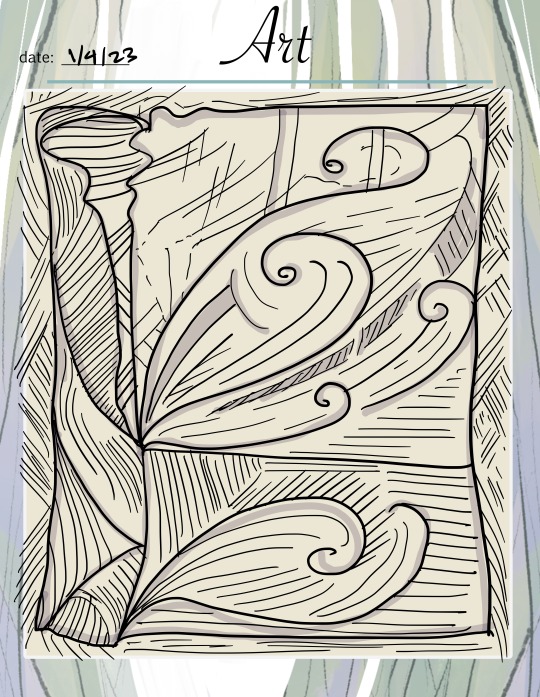
An art page from my journal
5 notes
·
View notes
